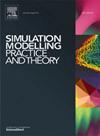采用增强睡眠/清醒调度和自适应路由过程的wsn双阶段协同能量管理方法
IF 3.5
2区 计算机科学
Q2 COMPUTER SCIENCE, INTERDISCIPLINARY APPLICATIONS
引用次数: 0
摘要
无线传感器网络(WSNs)已经成为各种应用中的基本技术之一,但由于其有限的能源,它们面临着巨大的挑战。为了克服这一缺点,本研究提出了一种创新的双阶段协同能量管理方法,该方法集成了基于多目标粒子群优化与拥挤距离(MOPSOCD)的增强睡眠/觉醒调度和基于水库计算(RC)的自适应路由,利用基于动态实时的节点状态调整机制优化能量消耗。通过综合模拟获得的实验结果表明,与最先进的算法相比,我们提出的方法可以将每个节点的能耗降低32%,在延长网络生命周期方面提高50%,并在分组传输比(PDR)方面提高11%。此外,该方法将计算开销减少了40%,保证了动态环境条件下的可靠性。这种出色的性能归功于rc驱动的能量预测与自适应路由和优化聚类的智能集成,这为wsn的能量管理策略提供了显著的进步,为可持续和可靠的网络部署铺平了道路。本文章由计算机程序翻译,如有差异,请以英文原文为准。
An innovative dual-phased synergistic energy management approach for WSNs using enhanced sleep/awake scheduling and adaptive routing process
Wireless Sensor Networks (WSNs) have established themselves as one of the essential technologies in various applications, yet they face significant challenges due to their limited energy resources. To overcome this shortcoming, this work introduces an innovative dual-phased synergistic energy management approach that integrates enhanced sleep/awake scheduling based on Multi-Objective Particle Swarm Optimization with Crowding Distance (MOPSO![]() CD) and Reservoir Computing (RC) based adaptive routing for optimizing energy consumption using dynamic real time-based node state adjustment mechanism. Experimental outcomes obtained through comprehensive simulations indicate that our proposed methodology achieves up to 32 % reduction in energy consumption per node, a 50 % improvement in extending network lifetime, and a 11 % enhancement in Packet Delivery Ratio (PDR) compared to state-of-the art algorithms. Additionally, the proposed method minimizes the computational overhead by 40 % which ensures reliability in dynamic environmental conditions. This outstanding performance is attributed to the intelligent integration of RC-driven energy predictions with adaptive routing and optimized clustering, which offers significant advancement in energy management strategies for WSNs, paving the path for sustainable and reliable network deployment.
CD) and Reservoir Computing (RC) based adaptive routing for optimizing energy consumption using dynamic real time-based node state adjustment mechanism. Experimental outcomes obtained through comprehensive simulations indicate that our proposed methodology achieves up to 32 % reduction in energy consumption per node, a 50 % improvement in extending network lifetime, and a 11 % enhancement in Packet Delivery Ratio (PDR) compared to state-of-the art algorithms. Additionally, the proposed method minimizes the computational overhead by 40 % which ensures reliability in dynamic environmental conditions. This outstanding performance is attributed to the intelligent integration of RC-driven energy predictions with adaptive routing and optimized clustering, which offers significant advancement in energy management strategies for WSNs, paving the path for sustainable and reliable network deployment.
求助全文
通过发布文献求助,成功后即可免费获取论文全文。
去求助
来源期刊

Simulation Modelling Practice and Theory
工程技术-计算机:跨学科应用
CiteScore
9.80
自引率
4.80%
发文量
142
审稿时长
21 days
期刊介绍:
The journal Simulation Modelling Practice and Theory provides a forum for original, high-quality papers dealing with any aspect of systems simulation and modelling.
The journal aims at being a reference and a powerful tool to all those professionally active and/or interested in the methods and applications of simulation. Submitted papers will be peer reviewed and must significantly contribute to modelling and simulation in general or use modelling and simulation in application areas.
Paper submission is solicited on:
• theoretical aspects of modelling and simulation including formal modelling, model-checking, random number generators, sensitivity analysis, variance reduction techniques, experimental design, meta-modelling, methods and algorithms for validation and verification, selection and comparison procedures etc.;
• methodology and application of modelling and simulation in any area, including computer systems, networks, real-time and embedded systems, mobile and intelligent agents, manufacturing and transportation systems, management, engineering, biomedical engineering, economics, ecology and environment, education, transaction handling, etc.;
• simulation languages and environments including those, specific to distributed computing, grid computing, high performance computers or computer networks, etc.;
• distributed and real-time simulation, simulation interoperability;
• tools for high performance computing simulation, including dedicated architectures and parallel computing.
 求助内容:
求助内容: 应助结果提醒方式:
应助结果提醒方式:


